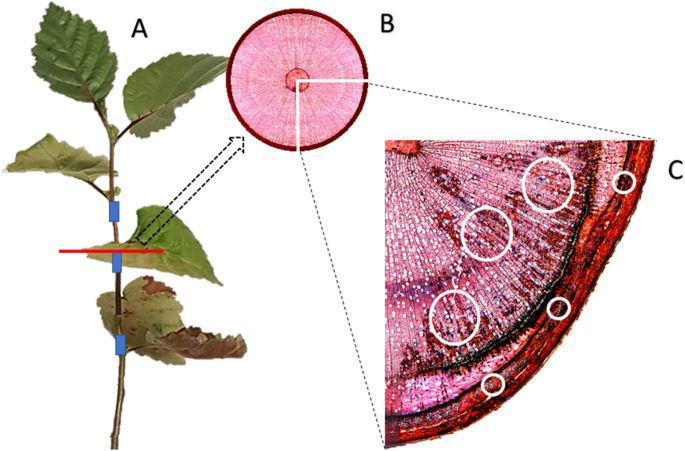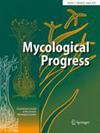黑桤木疫霉和盐疫霉的致病性及宿主的组织学反应
IF 3
3区 生物学
Q3 MYCOLOGY
引用次数: 0
摘要
欧洲沿岸桤木林受到疫霉的威胁。疫霉致病性的比较研究对于制定有效的管理策略至关重要。虽然在自然环境中,只有有限的物种,特别是P. x . alni,导致树木衰退,但许多物种在接种试验中显示出致病性。疫霉感染不同组织(如韧皮部和木质部)的能力各不相同,并通过形成tylose和callose引发寄主的防御反应。通过比较桤木对不同疫霉物种的组织学反应,我们可以深入了解P. xalni的成功以及其他物种可能造成的潜在危害。为了研究西班牙加泰罗尼亚地区黑桤木(Alnus glutinosa)对疫霉菌和盐疫霉菌的防御策略,我们对9种潜在致病性疫霉菌幼树进行了接种试验,并比较了其组织学反应。疫霉(Phytophthora × alni)和多角疫霉(P. plurivora)是最具侵染力的外来种,其次是P. xcambivora和P. cactorum。在自然环境中,尽管在衰退桤木中疫霉的流行率较高,但疫霉和多形疫霉的危害是相同的。虽然P. x alni主要侵入韧皮部,但P. plurivora也侵入木质部并引发泰氨酸的产生。组织学分析揭示了植物对疫霉菌感染的多种反应,与单纯观察病变相比,可以更好地了解它们在自然环境中的适应性。与低致病性菌种接种的幼树相比,接种扁豆的幼树胼胝质产量较低,这表明扁豆可以逃避宿主的识别,因此可以部分解释其成功的原因。本文章由计算机程序翻译,如有差异,请以英文原文为准。

Pathogenicity of Phytophthora and Halophytophthora species on black alder and the host histological response
Abstract Riparian alder forests are threatened by Phytophthora across Europe. Comparative studies of the pathogenicity of Phytophthora species are crucial for developing effective management strategies. Although only a limited number of species, particularly P. × alni , lead to tree decline in natural environments, many species demonstrate pathogenicity in inoculation trials. Phytophthora species vary in their ability to infect different tissues, such as phloem and xylem, and trigger defence responses in the host through the formation of tyloses and callose. By comparing the histological responses of alder to various Phytophthora species, we can gain insights into the success of P. × alni and the potential damage that could be caused by other species. To investigate the defence strategies of black alder ( Alnus glutinosa ) against attack by Phytophthora and Halophytophthora species present in Catalonia (NE Spain), we conducted inoculation trials on saplings using nine potentially pathogenic species and compared the histological responses. Phytophthora × alni and P. plurivora were the most aggressive species followed by other exotic species such as P. × cambivora and P. cactorum . Phytophthora × alni and P. plurivora were equally damaging despite the higher prevalence of P. × alni in declining alders in natural settings. Although P. × alni mainly invaded the phloem, P. plurivora also invaded the xylem and triggered the production of tyloses. Histological analyses revealed a diverse range of plant responses to infection by Phytophthora species, providing a better understanding of their adaptability in natural environments compared with solely observing lesions. The low level of callose production in saplings inoculated with P. × alni compared with callose production in saplings inoculated with less pathogenic species suggests that P. × alni can evade recognition by the host and, hence, could partially explain its success.
求助全文
通过发布文献求助,成功后即可免费获取论文全文。
去求助
来源期刊

Mycological Progress
生物-真菌学
CiteScore
4.50
自引率
8.30%
发文量
94
审稿时长
6-12 weeks
期刊介绍:
Mycological Progress publishes papers on all aspects of fungi, including lichens. While Review Papers are highly welcome, the main focus is on Research Articles on
Taxonomy and Systematics
Evolution
Cell Biology
Ecology
Biotechnology
Pathology (plants, animals, humans)
Manuscripts on current methods applied in, e.g., morphology, anatomy, ultrastructure (TEM, SEM), genetics, molecular biology, chemistry, and physiology will also be considered.
 求助内容:
求助内容: 应助结果提醒方式:
应助结果提醒方式:


